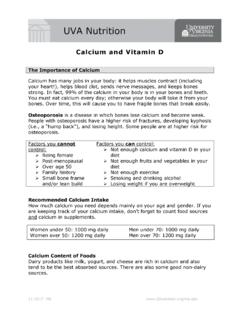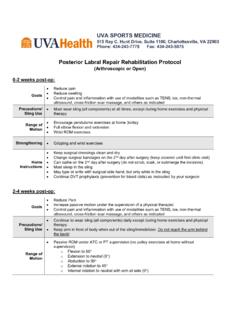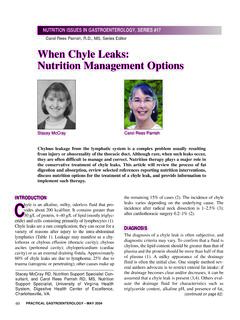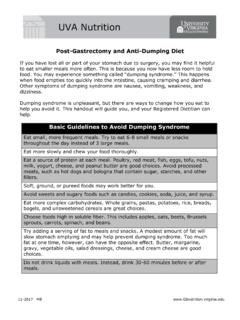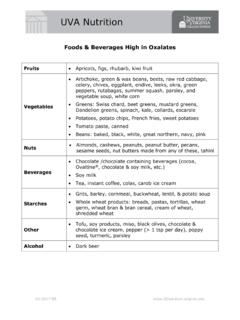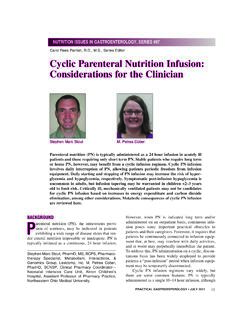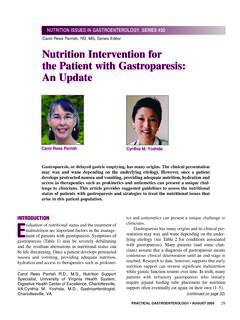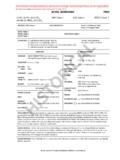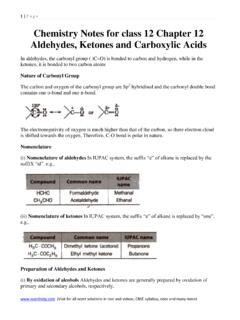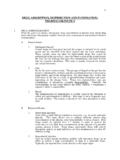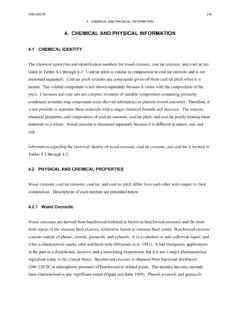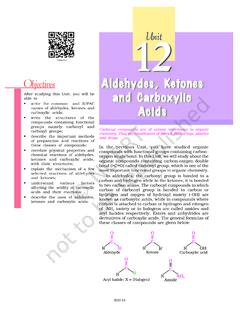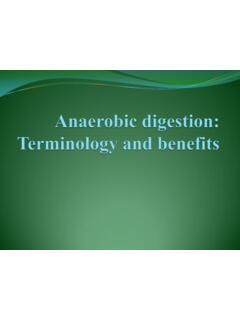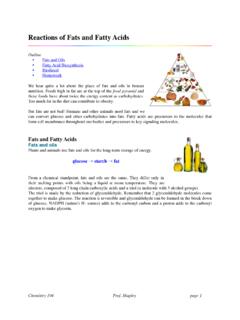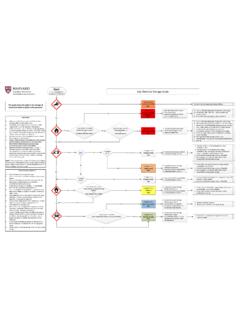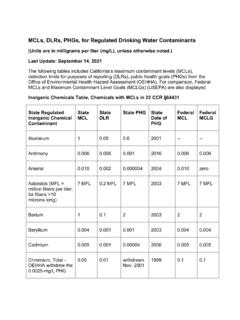Transcription of The Use of Medium-Chain Triglycerides in Gastrointestinal ...
1 NUTRITION ISSUES IN GASTROENTEROLOGY, SERIES #160 Carol Rees Parrish, , , Series Editor20 PRACTICAL GASTROENTEROLOGY FEBRUARY 2017 NUTRITION ISSUES IN GASTROENTEROLOGY, SERIES #160 The Use of Medium-Chain Triglycerides in Gastrointestinal DisordersNeha D. Shah, MPH, RD, CNSC Berkeley N. Limketkai, MD Digestive Health Center, Stanford Health Care Division of Gastroenterology & Hepatology Stanford University School of Medicine, Palo Alto, CANeha D. ShahBerkeley N. LimketkaiINTRODUCTIONM edium-chain Triglycerides (MCTs) comprise a glycerol molecule attached to 3 fatty acid chains ranging between 6 to 12 carbons in length. Unlike most other lipid molecules that require a complex process of digestion, MCTs are more easily absorbed into the bloodstream from the Gastrointestinal tract. These features of MCTs confer unique benefits in the management of Gastrointestinal As such, MCTs have historically been used to treat steatorrhea resulting from malabsorptive disorders, such as pancreatic insufficiency, prior gastrectomy and small bowel resection.
2 MCTs have also been investigated for their potential to reduce obesity, cardiovascular disease, and neurological disorders. The purpose of this review is to describe the composition, functional characteristics and sources of MCTs, as well as to review the evidence investigating the use of MCTs in the management of Gastrointestinal fatty acid is a simple lipid molecule with a carboxylic acid group on one end and a hydrocarbon chain on the The hydrocarbon chain length may range from 4 to 28 carbons and determines the classification of fatty acids: short chain (< 6 carbons), medium chain (6 to 12 carbons), long chain (13 to 21 carbons), and very long chain ( 22 carbons). Triglycerides are lipid Medium-Chain Triglycerides (MCTs) are lipid molecules that are more readily absorbed and oxidized than most lipids. This unique characteristic of MCTs has led to interest in their use in the management of several Gastrointestinal disorders, where MCTs have been primarily used to reduce fat malabsorption and to serve as a source of calories to optimize nutritional status.
3 In this review, we discuss the composition of MCTs, its sources, and the roles that they potentially play in the treatment of various Gastrointestinal disorders. NUTRITION ISSUES IN GASTROENTEROLOGY, SERIES #160 The Use of Medium-Chain Triglycerides in Gastrointestinal DisordersPRACTICAL GASTROENTEROLOGY FEBRUARY 2017 21 NUTRITION ISSUES IN GASTROENTEROLOGY, SERIES #160molecules with three fatty acids attached to a glycerol backbone. Similar to simple fatty acids, the length of the fatty acid group determines the nomenclature of short-chain Triglycerides (SCTs), Medium-Chain Triglycerides (MCTs), and long-chain Triglycerides (LCTs). The presence of double bonds can vary within fatty acids. Saturated fatty acids do not contain any double bonds along the hydrocarbon chain, while unsaturated fatty acids do. Monounsaturated fatty acids contain a single double bond, while polyunsaturated fatty acids contain two or more double bonds.
4 Most fatty acids can be endogenously synthesized, except for two long-chain polyunsaturated fatty acids: linoleic acid (18 carbons with 2 cis bonds at C9 and C12) and linolenic acid (18 carbons with 3 cis bonds at C9, C12, C15); these are considered essential fatty acids (EFAs) and must be obtained from the diet. The fatty acid groups of MCTs include caproic acid , caprylic acid , capric acid , and lauric acid . Compared with LCTs, MCTs are smaller in molecular weight, water soluble, rapidly oxidized for energy, possess a lower smoke point (the temperature when volatile substances are produced and a blue-colored smoke is seen as a result of oxidation of oil) and are liquid at room temperature. MCTs only contain saturated fatty acids and therefore do not contain either of the EFAs, linoleic and linolenic acid . As MCTs do not contain EFAs, they also do not serve as a precursor to the synthesis of eicosanoids.
5 MCTs provide fewer calories per gram than LCTs, vs. , respectively. Digestion and Absorption The length of the fatty acid influences the process of its digestion and absorption within the Gastrointestinal tract. The entry of Triglycerides as LCTs from the stomach into the duodenum stimulates the enteric secretion of the hormone cholecystokinin (CCK) and pancreatic enzymes from the pancreas. CCK promotes further release of bile from the gallbladder to help emulsify the Triglycerides into smaller fat droplets to maximize its ,4 Pancreatic lipase then cleaves the fatty acid chains from the Triglycerides to form individual fatty acid molecules that then aggregate into micelles. Micelles are absorbed into the enterocytes along the intestinal brush border via passive diffusion or are shuttled by fatty acid transporters. Once in the Table 1. Comparison of Characteristics between MCTs and LCTsCharacteristicsMedium Chain TriglyceridesLong Chain TriglyceridesPropertiesWater smoke no essential fatty smoke essential fatty saturated fatty to 21 hydrocarbons (long chain).
6 22 hydrocarbons (very long chain).Both are saturated and unsaturated fatty calories per calories per not stimulate not require bile or pancreatic absorbed into portal circulation bound to not require carnitine for transport into the bile and pancreatic enzymes (lipase).Need to be incorporated into micelles, then into chylomicrons for entry into the lymphatic carnitine for transport into the tissue (less).Adipose tissue (more).22 PRACTICAL GASTROENTEROLOGY FEBRUARY 2017 NUTRITION ISSUES IN GASTROENTEROLOGY, SERIES #160 The Use of Medium-Chain Triglycerides in Gastrointestinal DisordersNUTRITION ISSUES IN GASTROENTEROLOGY, SERIES #159of MCTs and improved utilization even in states of protein deficiency (Table 1).SourcesMost fats and oils of animal and plant origin contain LCTs ( , fish, avocado, nuts, seeds, corn, peanut, safflower, and soybean oil). By contrast, natural sources of MCTs include coconut oil and palm kernel oil, although these oils also contain LCTs.
7 Commercial MCT formulations may either be comprised of naturally-derived MCT oil, 100% synthetic MCT oil (produced from Medium-Chain fatty acids that are hydrolyzed from coconut or palm kernel oil, purified, and then re-esterified onto a glycerol backbone), physical mixtures (blend of MCTs and LCTs), or structured lipids6 (Table 2). Structured lipids are synthetic lipid molecules with a mix of Medium-Chain and/or long-chain fatty acids attached to a glycerol backbone. In the clinical setting, it is not uncommon for healthcare professionals to tell their patients to use coconut oil to obtain MCTs. However, depending on the circumstance, this may worsen fat malabsorption due to the LCT content. Semi-elemental and elemental enteral formulas typically include MCTs to minimize need for digestion prior to absorption, although LCTs may also be included (continued on page 24)enterocytes, the fatty acids are transported into the endoplasmic reticulum, reconverted into Triglycerides , and packaged into chylomicrons.
8 The chylomicrons are released via exocytosis, enters and travels through the lymphatic system and eventually, drains into the subclavian vein to reach the bloodstream. In the intracellular space, long-chain fatty acids bind to carnitine for transport into the mitochondria for subsequent -oxidation. In carnitine deficiency states that contribute to severe protein malnutrition ( , chronic malabsorption, small bowel obstruction, starvation), these long-chain fatty acids cannot be efficiently utilized and instead lead to accumulation of unoxidized fatty acids and impairment of ureogenesis, ketogenesis, and Clinical sequelae may include hepatic steatosis, hepatomegaly, myopathy, and altered mental contrast, MCT digestion is rapid and simple. MCTs do not stimulate CCK ,4 MCT absorption occurs via passive diffusion along the Gastrointestinal tract into the portal system bound to albumin.
9 No further packaging or modification of the MCT molecules is required. Moreover, MCTs are not dependent on the carnitine acyltransferase system for transport into the mitochondria for This provides the ability for more rapid metabolism Table 2. Examples of Commercial Liquid MCT Oil ProductsProductKcal/ 1 TBSP (15 mL)Kcal/4 TBSP (60 mL)Nature s Way Coconut Premium Oil (20 oz. bottle 93% MCT, 7% LCT) kcal/13 g520 kcal/52 g Nestle Health Science MCT Oil (32 oz. bottle 100% MCT) kcal/14 g460 kcal/56 g Now Foods MCT Oil (32 oz. bottle 100% MCT) kcal/14 kg400 kcal/56 g If unopened, the product can be stored in a cool dry place and once opened, can be stored at room temperature or in the refrigerator. The inclusion of these commercial products is not meant to recommend any specific product. 24 PRACTICAL GASTROENTEROLOGY FEBRUARY 2017 NUTRITION ISSUES IN GASTROENTEROLOGY, SERIES #160 The Use of Medium-Chain Triglycerides in Gastrointestinal Disordersas a source of EFAs (Table 3).
10 Clinical applications may include malabsorption disorders from pancreatic insufficiency or severe small bowel disease. Dosage Excessive intake of oral MCT oil has been associated with Gastrointestinal distress, such as abdominal discomfort, cramping, gassiness, bloating, and diarrhea. A tablespoon (15 mL) of MCT oil contains 14 grams of fat and 115 calories. A maximum daily dose of 50-100 grams has been suggested for improved Gastrointestinal tolerance; this is equivalent to 4-7 tablespoons (60-100 mL) per day (56-98 grams of fat and 460-805 calories).1 The daily dose of MCTs should be increased as tolerated to the maximum daily dose, while equally dividing the dose across all meals. The MCTs can be easily mixed into a variety of foods and beverages. If MCTs are used in cooking, the temperature should be kept below 150o C (302o F) to reduce risk of its oxidation, otherwise the flavor of the food could be A tablespoon of MCT oil can also be administered through a feeding tube using a syringe along with a 30 ml water flush before and after its administration (See Table 4).

